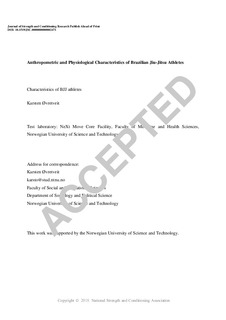| dc.contributor.author | Øvretveit, Karsten | |
| dc.date.accessioned | 2019-03-14T10:10:49Z | |
| dc.date.available | 2019-03-14T10:10:49Z | |
| dc.date.created | 2018-08-15T07:55:22Z | |
| dc.date.issued | 2018 | |
| dc.identifier.citation | Journal of Strength and Conditioning Research. 2018, 32 (4), 997-1004. | nb_NO |
| dc.identifier.issn | 1064-8011 | |
| dc.identifier.uri | http://hdl.handle.net/11250/2589974 | |
| dc.description.abstract | Øvretveit, K. Anthropometric and physiological characteristics of Brazilian jiu-jitsu athletes. J Strength Cond Res 32(4): 997–1004, 2018—The aim of this study was to describe anthropometric and physiological characteristics of Brazilian jiu-jitsu (BJJ) athletes. For this purpose, 42 male athletes were recruited from one of the largest BJJ academies in central Norway. The subjects were 32 ± 6 (SD) years old, 181.9 ± 7.2 cm tall, had a body mass (mb) of 85.7 ± 10.6 kg, and 5.5 ± 3.7 years of BJJ training experience. The subjects underwent segmental multifrequency bioelectrical impedance analysis of body composition (BIA), direct measurements of pulmonary function and maximal oxygen uptake (V[Combining Dot Above]O2max), assessments of 1-repetition maximum (1RM) in the parallel squat and paused bench press, and one set of pronated-grip pull-ups to muscular failure. The average body fat percentage (BF) was 12.9 ± 5.3%. The subjects achieved a V[Combining Dot Above]O2max of 50.6 ± 4.6 mL·kg−1·min−1. Absolute squat 1RM (113.2 ± 20.4 kg) was significantly higher than bench press 1RM (87.6 ± 16.5 kg) (p < 0.001). The mean number of pull-ups achieved was 9 ± 4. These characteristics were generally independent of rank, training experience, weekly training volume, competition volume, and style preference. Additional strength training was associated with improved bench press performance (p < 0.05). Beyond that, additional strength and/or conditioning training had no apparent relationship with any variable (p > 0.05). This study provides novel insight into the fitness levels of BJJ athletes. These findings indicate the degree of exercise response to BJJ training and are applicable in athlete assessment and exercise prescription in this population. | nb_NO |
| dc.language.iso | eng | nb_NO |
| dc.publisher | Lippincott, Williams & Wilkins | nb_NO |
| dc.title | Anthropometric and Physiological Characteristics of Brazilian Jiu-Jitsu Athletes | nb_NO |
| dc.title.alternative | Anthropometric and Physiological Characteristics of Brazilian Jiu-Jitsu Athletes | nb_NO |
| dc.type | Journal article | nb_NO |
| dc.type | Peer reviewed | nb_NO |
| dc.description.version | acceptedVersion | nb_NO |
| dc.source.pagenumber | 997-1004 | nb_NO |
| dc.source.volume | 32 | nb_NO |
| dc.source.journal | Journal of Strength and Conditioning Research | nb_NO |
| dc.source.issue | 4 | nb_NO |
| dc.identifier.doi | 10.1519/JSC.0000000000002471 | |
| dc.identifier.cristin | 1602072 | |
| dc.description.localcode | © 2018. This is the authors’ accepted and refereed manuscript to the article. Locked until 1.4.2019 due to copyright restrictions. | nb_NO |
| cristin.unitcode | 194,67,25,0 | |
| cristin.unitname | Institutt for sosiologi og statsvitenskap | |
| cristin.ispublished | true | |
| cristin.fulltext | original | |
| cristin.qualitycode | 1 | |
